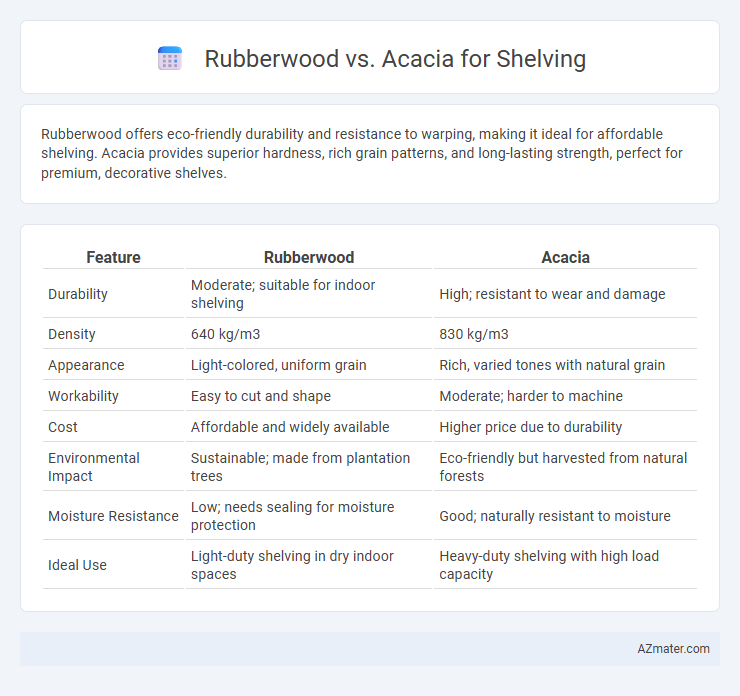Rubberwood offers eco-friendly durability and resistance to warping, making it ideal for affordable shelving. Acacia provides superior hardness, rich grain patterns, and long-lasting strength, perfect for premium, decorative shelves.
Table of Comparison
| Feature | Rubberwood | Acacia |
|---|---|---|
| Durability | Moderate; suitable for indoor shelving | High; resistant to wear and damage |
| Density | 640 kg/m3 | 830 kg/m3 |
| Appearance | Light-colored, uniform grain | Rich, varied tones with natural grain |
| Workability | Easy to cut and shape | Moderate; harder to machine |
| Cost | Affordable and widely available | Higher price due to durability |
| Environmental Impact | Sustainable; made from plantation trees | Eco-friendly but harvested from natural forests |
| Moisture Resistance | Low; needs sealing for moisture protection | Good; naturally resistant to moisture |
| Ideal Use | Light-duty shelving in dry indoor spaces | Heavy-duty shelving with high load capacity |
Introduction to Rubberwood and Acacia
Rubberwood, derived from the Para rubber tree, is a sustainable hardwood known for its light color and fine grain, making it ideal for modern shelving designs. Acacia, a dense hardwood native to Australia and Southeast Asia, offers rich, warm hues and exceptional durability, often favored for high-traffic storage solutions. Both materials provide unique aesthetic and functional benefits, with Rubberwood excelling in eco-friendliness and Acacia in strength and longevity.
Key Characteristics of Rubberwood
Rubberwood is a sustainable hardwood sourced from Para rubber trees after latex extraction, featuring a light-colored, fine grain that offers excellent paint and stain absorption for customizable finishes. Its moderate hardness and durability make it suitable for shelving that requires strength without excessive weight. Rubberwood's resistance to warping and its eco-friendly credentials provide an attractive option for environmentally conscious furniture design.
Key Characteristics of Acacia Wood
Acacia wood features a rich, warm grain pattern with high durability and resistance to scratches, making it ideal for heavy-use shelving. Its natural oils provide moisture resistance, enhancing longevity in humid environments. The wood's density and strength ensure stable, long-lasting shelves that support substantial weight without warping.
Durability: Rubberwood vs Acacia
Rubberwood offers moderate durability, making it suitable for light to medium shelving but more prone to dents and scratches over time. Acacia is a hardwood known for its exceptional strength and resistance to wear, providing superior durability for heavy-duty shelving needs. Choosing Acacia ensures longer-lasting shelves with better resistance to impact and moisture compared to Rubberwood.
Appearance and Grain Patterns
Rubberwood features a light beige to pale yellow color with a relatively straight and consistent grain, offering a smooth and uniform appearance ideal for modern and minimalistic shelving designs. Acacia displays rich, varied hues ranging from golden brown to deep reddish tones, with striking, naturally swirling grain patterns that create an eye-catching, textured look perfect for rustic or statement shelving pieces. Both woods provide durability, but Acacia's distinctive grain and color variation make it the preferred choice for shelves where visual impact and natural beauty are priorities.
Environmental Impact and Sustainability
Rubberwood is a highly sustainable choice for shelving due to its use as a byproduct of the latex industry, harvesting mature trees without deforestation and promoting reforestation. Acacia, while durable and resistant, often involves slower growth rates and increased resource consumption, which may raise environmental concerns if not sourced responsibly from well-managed plantations. Choosing rubberwood supports circular economy principles by utilizing plantation waste, reducing carbon footprint compared to hardwoods like acacia that may require longer growth cycles and more intensive land use.
Cost Comparison
Rubberwood is generally more affordable than Acacia, making it a popular choice for budget-conscious shelving projects. While Rubberwood offers good durability and a light, uniform appearance, Acacia is priced higher due to its dense grain, natural resistance to wear, and rich color tones. For long-term investment, Acacia's strength and aesthetic appeal may justify the initial higher cost despite Rubberwood's lower upfront price.
Ease of Maintenance
Rubberwood offers ease of maintenance due to its smooth grain and resistance to warping, requiring only regular dusting and occasional oiling to maintain its appearance. Acacia, while denser and more durable, needs periodic sealing or varnishing to prevent moisture damage and maintain its rich tones. Both woods are relatively low-maintenance, but rubberwood's natural resistance to cracking and simpler upkeep make it a preferred choice for hassle-free shelving care.
Best Uses for Rubberwood and Acacia in Shelving
Rubberwood is ideal for shelving that requires a smooth, uniform surface and moderate strength, making it well-suited for lightweight decorative shelves and storage units in dry environments. Acacia offers exceptional durability and moisture resistance, making it perfect for heavier load-bearing shelves, kitchen shelving, and areas prone to humidity. Both woods provide attractive finishes, but Rubberwood excels in affordability and sustainability, while Acacia stands out for its dense hardness and natural resistance to wear.
Final Recommendation: Which Wood is Better for Shelving?
Rubberwood offers affordability, durability, and a light, consistent grain that suits modern shelving designs, making it an excellent choice for cost-effective and eco-friendly options. Acacia provides superior hardness, natural resistance to moisture, and a rich, varied grain pattern ideal for high-end, decorative shelves requiring long-lasting strength. For budget-friendly, sustainable shelving, rubberwood is preferable, whereas acacia is better for premium, heavy-duty applications where aesthetics and toughness are prioritized.

Infographic: Rubberwood vs Acacia for Shelving
 azmater.com
azmater.com